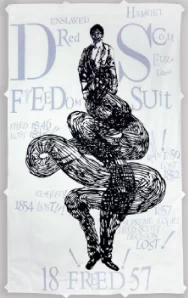The Power of Speech and History from Lesley Dill’s Wilderness: Light Sizzles Around Me
So far this semester, my involvement in the installation process of Lesley Dill’s exhibition, Wilderness: Light Sizzles Around Me, was one of the most influential experiences I have had working at the Bates Museum of Art. On my second day as an intern, I was pleasantly surprised when I was called to the museum’s upper gallery. I was assigned to help complete condition reports for the pieces being installed. This task involved time, patience, and attention to detail of the piece being analyzed. This exhibition highlights a number of revolutionaries of literature and activists such as Emily Dickinson, John Brown, Sojourner Truth, Anne Hutchinson, and Dred Scott. The works in this exhibition were not only detailed but were also made with many different materials such as paper, paint, thread, cloth, and pencil. All of these materials react differently when faced with being transported, unwrapped, and installed. The collection mainly contained cloth banners with painted excerpts and fashion pieces with exposed seams. I searched for and reported damages, cracking paint, smudging, loose stitches, or marks that did not look intentional. I remember on my first day filling out these condition reports, Dan Mills, museum director, shared some very valuable information with me. He said that the average viewer in the gallery or museum spends about 7 to 15 seconds looking at a piece of artwork before they move on to the next. When one is completing condition reports, 10 to 15 minutes can be spent with each piece. You are able to notice the details, gaining a greater understanding of the work and how it was made. With this new realization, I no longer thought of this task as tedious or taxing. In fact, it became the opposite. It was an opportunity for me to get up close and personal with the piece. Working behind the scenes of the exhibition, I was able to get as close as I wanted and to spend as much time as I wanted with the piece, analyzing these fascinating artworks in a way that I had never done before. Lesley Dill came to Bates College during the week of March 7th, 2022 and gave a gallery talk about her exhibition. She explained her inspiration was sparked by her lifelong fascination with Emily Dickinson and poetry, so she began researching the historical context surrounding her. This exhibition highlights the words of people who fought for something whether it be for equal rights, religious beliefs, or the protection of their people. One of the most fascinating aspects of this exhibition was the depth of research and Dill’s commitment to honoring the history of these very different American figures. In the pieces about Mother Ann Lee and Black Hawk, Dill visited the home of the Shakers in upstate New York. She spoke with Native Americans about how to respectfully and properly depict Black Hawk and his cause. The detailed research can be seen throughout the exhibition, including the title of the exhibition, Wilderness: Light Sizzles Around Me is a very poignant and complex title. It starts with the word “wilderness” itself. The word wilderness comes from old-English roots; “wild” meaning “uncultivated,” and “ness” meaning “deer or wild animal”. Dill even spells the word in its original spelling “Wild-eor-ness” on the opening banner. According to Dill, “wilderness is an invitation.” It is terrifying yet comforting, it is dangerous, but also a place for nurture. She also juxtaposes the historical context of early New England in the sense that for the white settlers, the thick woods were a terrifying mystery, but for the Native Americans the wilderness was their home and source of life.
For me personally, the most interesting piece, both symbolically and visually, is the Dred Scott banner. It also just so happens to be the first piece in the exhibition that I worked with. Dred Scott (1799-1858) and his wife Harriet are known for the series of lawsuits with the St. Louis Court. As shown on the banner, they filed for the first time in 1846 and lost in 1847. They filed again in 1854, but lost this second time. Won in 1850, lost in 1852, and then faced the Supreme Court in 1857 which resulted in the infamous Dred Scott decision which denied them their freedom. However, as shown on the bottom of the banner, the Scott family ultimately gained their freedom in 1857 after years of fighting when they were bought and then freed by the Blow family. Something I find interesting about this piece is how the date of each lawsuit is placed next to a curve or twist in the legs. A metaphor for each lawsuit being a twist in their lives and a divergence from gaining their freedom. However, by the end of this twisting and turning, Dred Scott lands on his feet and becomes freed as represented by the date of their freedom under the grounded and stable feet. As Lesley Dill states about this piece, “the banner reflects the twists and turns of their lives, like a river finding its true course,” and I could not say this better myself.
Clara Kennedy
Class of 2025
